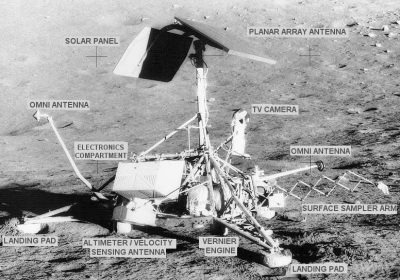Surveyor 7 was the seventh and last lunar lander of the American uncrewed Surveyor program sent to explore the surface of the Moon. A total of 21,091 pictures were transmitted to Earth.
Surveyor 7 was the fifth and final spacecraft of the Surveyor series to achieve a lunar soft landing. The objectives for this mission were to perform a lunar soft landing (in an area well removed from the maria to provide a type of terrain photography and lunar sample significantly different from those of other Surveyor missions); obtain postlanding TV pictures; determine the relative abundances of chemical elements; manipulate the lunar material; obtain touchdown dynamics data; and obtain thermal and radar reflectivity data. This spacecraft was similar in design to the previous Surveyors, but it carried more scientific equipment including a television camera with polarizing filters, a surface sampler, bar magnets on two footpads, two horseshoe magnets on the surface scoop, and auxiliary mirrors. Of the auxiliary mirrors, three were used to observe areas below the spacecraft, one to provide stereoscopic views of the surface sampler area, and seven to show lunar material deposited on the spacecraft. The spacecraft landed on the lunar surface on January 10, 1968, on the outer rim of the crater Tycho. Operations of the spacecraft began shortly after the soft landing and were terminated on January 26, 1968, 80 hours after sunset. On January 20, while the craft was still in daylight, the TV camera clearly saw two laser beams aimed at it from the night side of the crescent Earth, one from Kitt Peak National Observatory, Tucson, Arizona, and the other at Table Mountain at Wrightwood, California.Operations on the second lunar day occurred from February 12 to 21, 1968. The mission objectives were fully satisfied by the spacecraft operations. Battery damage was suffered during the first lunar night and transmission contact was subsequently sporadic. Contact with Surveyor 7 was lost on February 21, 1968.NASA and Bellcom mission planners considered the Surveyor 7 site as a potential target for a crewed late Apollo mission, perhaps Apollo 20, though a combination of operational constraints, including the high latitude of the site and its rough terrain, and the early cancellation of post-Apollo 17 lunar missions, contributed to the site's elimination.
Surveyor 7 was the first probe to detect the faint glow on the lunar horizon after dark that is now thought to be light reflected from electrostatically levitated Moon dust.
The Surveyor program was a NASA program that, from June 1966 through January 1968, sent seven robotic spacecraft to the surface of the Moon. Its primary goal was to demonstrate the feasibility of soft landings on the Moon. The Surveyor craft were the first American spacecraft to achieve soft landing on an extraterrestrial body. The missions called for the craft to travel directly to the Moon on an impact trajectory, a journey that lasted 63 to 65 hours, and ended with a deceleration of just over three minutes to a soft landing.The program was implemented by NASA's Jet Propulsion Laboratory (JPL) to prepare for the Apollo program, and started in 1960. JPL selected Hughes Aircraft in 1961 to develop the spacecraft system. The total cost of the Surveyor program was officially $469 million.
Five of the Surveyor craft successfully soft-landed on the Moon, including the first one. The other two failed: Surveyor 2 crashed at high velocity after a failed mid-course correction, and Surveyor 4 lost contact (possibly exploding) 2.5 minutes before its scheduled touch-down.
All seven spacecraft are still on the Moon; none of the missions included returning them to Earth. Some parts of Surveyor 3 were returned to Earth by the crew of Apollo 12, which landed near it in 1969. The camera from this craft is on display at the National Air and Space Museum in Washington, DC.

1968Jan, 7
Surveyor Program: Surveyor 7, the last spacecraft in the Surveyor series, lifts off from launch complex 36A, Cape Canaveral.
Choose Another Date
Events on 1968
- 30Jan
Tet Offensive
Vietnam War: Tet Offensive launch by forces of the Viet Cong and North Vietnamese Army against South Vietnam, the United States, and their allies. - 31Jan
Tet Offensive
Vietnam War: Viet Cong guerrillas attack the United States embassy in Saigon, and other attacks, in the early morning hours, later grouped together as the Tet Offensive. - 29Apr
Counterculture of the 1960s
The controversial musical Hair, a product of the hippie counter-culture and sexual revolution of the 1960s, opens at the Biltmore Theatre on Broadway, with some of its songs becoming anthems of the anti-Vietnam War movement. - 14Oct
U.S. Marine Corps
Vietnam War: The United States Department of Defense announces that the U.S. Army and U.S. Marine Corps will send about 24,000 soldiers and Marines back to Vietnam for involuntary second tours of duty in the combat zone there. - 20Oct
Jacqueline Kennedy
Former First Lady Jacqueline Kennedy marries Greek shipping tycoon Aristotle Onassis.

 English
English  español
español  français
français  português
português  русский
русский  العربية
العربية  简体中文
简体中文 